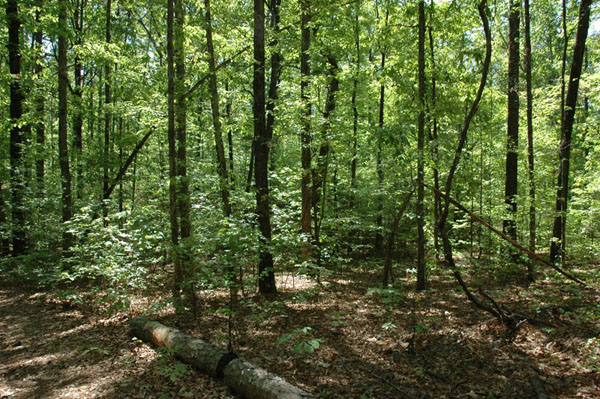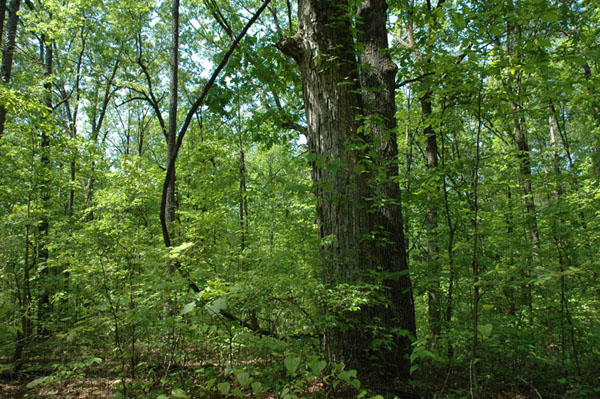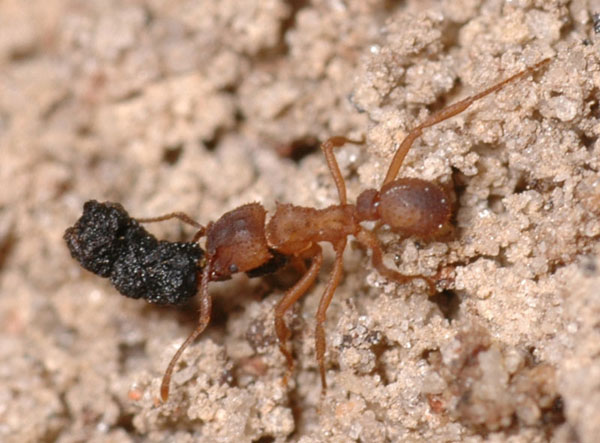Ants in Upland Hardwood Forests of Noxubee National Wildlife Refuge, Mississippi
Joe A. MacGown and JoVonn G. Hill
Click links to view ants in the primary habitat types at the Noxubee National Wildlife Refuge.
[Noxubee Ants-all habitats] [pine forests] [pine/hardwood forests] [bottomland hardwood forests] [upland hardwood forests] [fields, grasslands, & other open areas] [disturbed wooded areas]
A recent project was undertaken by the MEM to survey the Noxubee National Wildlife Refuge in Oktibbeha, Noxubee, and Winston Counties for ants. The refuge owns approximately 48,000 acres, which can be separated into three primary habitats: forests, fields and grasslands, and wetlands. By far, forests form the majority of the refuge and cover about 45,000 acres (about 93%). The forests can be further divided into four major types including pine (23,619 acres), mixed pine/hardwood (2,851 acres), bottomland hardwood (15,453 acres), and upland hardwood (3,263 acres). In this study we examined six terrestrial habitat types to determine species compositions for each habitat. Habitat types for this study included pine forests (both mature and young forests, and recently burned or unburned); bottomland hardwood forests (including cypress dominanted areas); upland hardwood forests; mixed pine/hardwood forests (including one area intermixed with cedar); open habitats including fields, grasslands, roadsides, and a sand pit; and disturbed, open mixed forests located near buildings and picnic areas. The latter disturbed sites were included because of their likelihood of being ideal habitats for various exotic species. In addition to the ants collected during this survey, the total list of species from the refuge includes earlier records of ants collected by the Mississippi Entomological Museum (MEM). Collecting methods included baiting, beating and sweeping vegetation, litter sampling, and visually searching for ants and their colonies. Our collections have revealed a diverse fauna, and we have collected 98 species (species list) at the refuge.
Upland hardwood forests are associated with sloped or rolling terrain and tend to be relatively xeric, except at ravine bottoms, and soils tend to be somewhat sandy. They are generally characterized by having an overstory of shade-tolerant deciduous trees with an understory of woody shrubs and herbaceous ground cover. The upland hardwood forests at Noxubee NWR are dominated by species such as white, southern red, and post oaks, black cherry and several hickories. Although upland hardwood forests account for only about 3,200 acres at the refuge, they provide important habitat for many ant species. Thus far we have found 56 species in upland hardwood habitat (species list below).
 |
 |
Upland hardwood forest at Scattertown Trail |
Upland hardwood forest at Scattertown Trail |
 |
 |
Crescentic mound of soil above entrance to Trachymyrmex septentrionalis colony |
Worker of Trachymyrmex septentrionalis carrying caterpillar feces to the colony. These ants cultivate fungus for food, which they grow on insect droppings and vegetative matter. |
Ants from Upland Hardwood Forests of the Noxubee National Wildlife Refuge
(Species are arranged alphabetically by genus)
Aphaenogaster carolinensis Wheeler
Aphaenogaster fulva Roger
Aphaenogaster lamellidens Mayr
Aphaenogaster mariae Forel
Aphaenogaster treatae Forel
Brachymyrmex depilis Emery
Camponotus americanus Mayr (pest)
Camponotus chromaiodes Bolton (pest)
Camponotus nearcticus Emery
Camponotus pennsylvanicus (DeGeer) (pest)
Camponotus snellingi Bolton (pest)
Colobopsis mississippiensis (Smith)
Crematogaster ashmeadi Mayr (pest)
Crematogaster lineolata (Say) (pest)
Crematogaster minutissima (Mayr)
Cryptopone gilva (Roger)
Cyphomyrmex rimosus (Spinola) (introduced)
Discothyrea testacea Roger
Formica dolosa Buren
Formica pallidefulva Latreille
Hypoponera opacior (Forel)
Lasius americanus Emery
Monomorium minimum (Buckley) (pest)
Myrmecina americana Emery
Myrmica punctiventris Roger
Nylanderia faisonensis (Forel)
Nylanderia parvula (Mayr)
Nylanderia sp.-01
Pheidole dentata Mayr (pest?)
Pheidole dentigula Smith
Pheidole metallescens Emery
Ponera exotica Smith
Ponera pennsylvanica Buckley
Prenolepis imparis (Say)
Proceratium crassicorne Emery
Proceratium silaceum Roger
Solenopsis carolinensis Forel ?? [appears to be this species]
Solenopsis invicta x richteri (introduced, pest)
Stenamma impar Forel
Stigmatomma pallipes (Haldeman)
Strumigenys angulata Smith
Strumigenys creightoni Smith
Strumigenys clypeata Roger
Strumigenys dietrichi Smith
Strumigenys hyalina (Bolton)
Strumigenys laevinasis Smith
Strumigenys louisianae Roger
Strumigenys missouriensis Smith
Strumigenys ohioensis Kennedy & Schramm
Strumigenys ornata Mayr
Strumigenys pilinasis Forel
Strumigenys pulchella Emery
Strumigenys rostrata Emery
Tapinoma sessile (Say) (pest)
Temnothorax americanus (Emery)
Temnothorax curvispinosus (Mayr)
Temnothorax pergandei (Emery)
Temnothorax schaumii (Roger)
Trachymyrmex septentrionalis (McCook)
Links
MacGown, J. A., J. G. Hill, T. L. Schiefer, and R. L. Brown. 2012. Ant diversity and habitat associations at the Noxubee National Wildlife Refuge in Mississippi. Mississippi Agricultural and Forestry Experiment Station Technical Bulletin 1197. [pdf]
Landmarks article about the Noxubee Study [pdf]
Noxubee National Wildlife Refuge [http://www.fws.gov/noxubee/]


